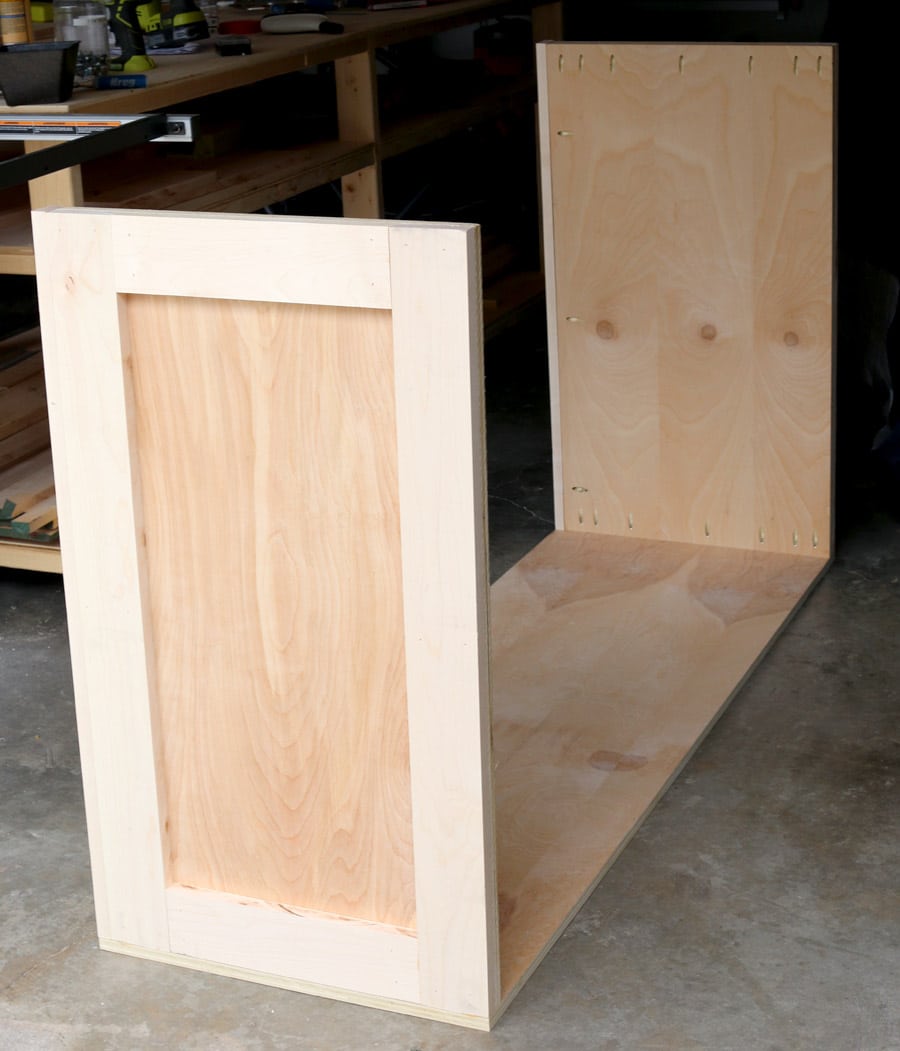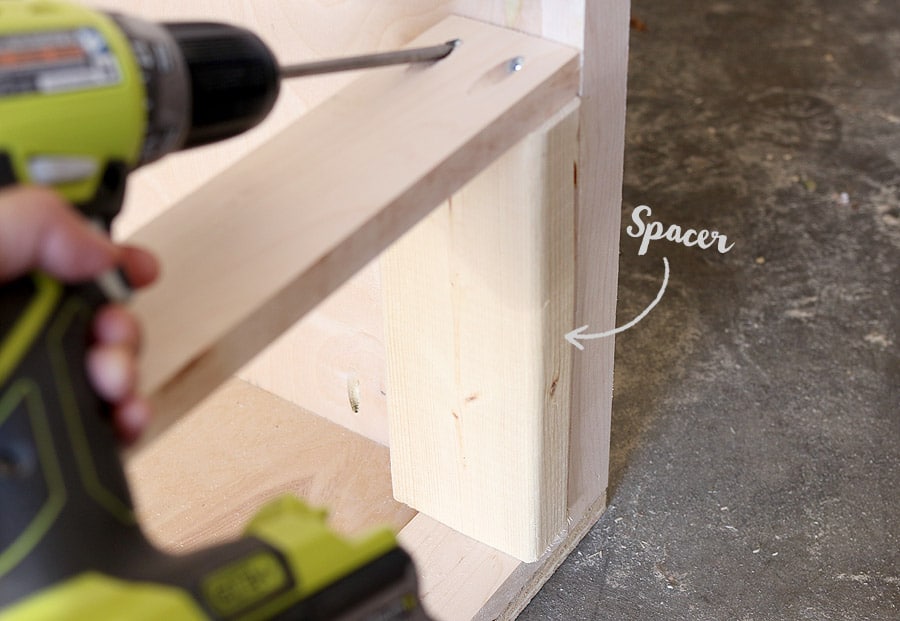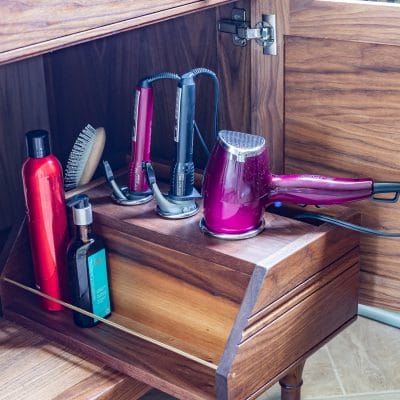Alright you guys. I’m going to be splitting this tutorial into separate parts because I want to share all the blood (yes, there was blood – but it’s not what you think), sweat (buckets of it thanks to the brutal Southern summer heat and humidity), and tears (because I am a girl, after all) it took to build this beast of a dresser.
If you’re just joining us, I’m building a 9-drawer dresser for my brother-in-law. First of all, I must have drawn up 10 different plans for this thing in my quest to find the best, most efficient, and soundest way of building it. You may remember my first and second attempts at designing my brother-in-law’s dresser. Yeah. Oh, and don’t forget the matching nightstands.
Read the complete tutorial:
- Part One: Building the Carcass (you’re here!)
- Part Two: Building the Large Drawers
- Part Three: Building the Small Drawers
- Part Four: The Final Details

 As usual, I used my favorite plywood, Purebond Plywood for the sides and bottom. It’s the prettiest plywood at The Home Depot. I bought the 3/4″ maple species.
As usual, I used my favorite plywood, Purebond Plywood for the sides and bottom. It’s the prettiest plywood at The Home Depot. I bought the 3/4″ maple species.
Oh, and here’s a first – I bought my lumber from a lumber distributor and ripped and planed my own boards! You guys. I googled “lumber distributor” or “lumber wholesaler” in my area and let me tell you: LIFE-CHANGING. Not only do they carry a wide array of wood species (maple, alder, cherry, mahogany, walnut, etc.), but the boards are nicer and usually half the cost of the big box stores! I know, RIGHT?! Heart eyes all over the place, y’all. And I love supporting local small businesses, don’t you?
Seriously, I was like a kid in a candy store at my local lumberyard. Now, the main difference is lumberyards will charge by the board foot and not the linear foot (like the big box stores), so I’d recommend you familiarize yourself with calculating board feet to figure out how much material you’ll need for your projects. But the short version is: one board foot = 12″ by 12″ by 1″. And the formula to calculate board feet is: length x width x thickness / 144.
So let’s say I want to buy a 1×8 8-foot board. The cost per board foot for maple is about $2.63 where I live so I’d calculate (I round up just to make things easier) length x width x thickness: 96 x 8 x 1 = 768, then divide that number by 144 = 5.3333333… so that board is approximately 5.3333333 board feet, right? Then I take 5.3333333… and multiply that by $2.63 (price per board foot) = $14.03. So I’ll pay about $14 for that 1x8x8 maple board. Make sense?
One day I’ll dedicate a whole post on this subject because there’s a lot to learn and consider when purchasing lumber from a lumberyard, but in the meantime, this video covers the basics.
 Also, if you don’t own a table saw or a planer, buying your lumber from a lumberyard won’t do you much good because you’ll need to prepare your stock before you build with it. Lumber sold in lumberyards usually come in random widths, so you’ll have to rip your boards on a table saw to whatever width you need for your project. Also, at my lumberyard, the boards are 1/16″ thicker than 3/4″ so I had to plane them down to a true 3/4″ thickness first. I chose to use maple for both my solid wood boards and plywood.
Also, if you don’t own a table saw or a planer, buying your lumber from a lumberyard won’t do you much good because you’ll need to prepare your stock before you build with it. Lumber sold in lumberyards usually come in random widths, so you’ll have to rip your boards on a table saw to whatever width you need for your project. Also, at my lumberyard, the boards are 1/16″ thicker than 3/4″ so I had to plane them down to a true 3/4″ thickness first. I chose to use maple for both my solid wood boards and plywood.
First, I cut my plywood side panels to size and drilled 3/4″ pocket holes facing up, down, and towards the front. I used a table saw to rip my plywood, but you can also use a circular saw with a straight edge. Then I attached the 1×4 “trim” to the plywood sides with wood glue and 1-1/4″ brad nails. Next I attached the trimmed out sides to the bottom with 1-1/4″ pocket hole screws and glue.
 So I talked about shedding blood earlier. This is why I belong in the workshop and not in the kitchen. One night, I was cutting up some tomatoes for dinner and sliced about 1/16″ off my thumb. Well, not all the way off. It was hanging by a thread, so I had this ‘flap’ of thumb just waving in the wind. Gross, I know, but hello?! Thank God it wasn’t a table saw or a compound miter saw, right?! Whew (for a second there)!
So I talked about shedding blood earlier. This is why I belong in the workshop and not in the kitchen. One night, I was cutting up some tomatoes for dinner and sliced about 1/16″ off my thumb. Well, not all the way off. It was hanging by a thread, so I had this ‘flap’ of thumb just waving in the wind. Gross, I know, but hello?! Thank God it wasn’t a table saw or a compound miter saw, right?! Whew (for a second there)!
Kitchen knife. I know: shenaniganry.
And do you know how challenging it is to build with a gimpy thumb? Extremely.
 Now that I had my sides and bottom constructed, it was time to add the horizontal supports (i.e. build the carcass). I used 1×3 boards for these supports. I cut a couple of 2x4s to 9-1/2″ long to serve as spacers. They were really useful in holding my boards up while I drove the screws in.
Now that I had my sides and bottom constructed, it was time to add the horizontal supports (i.e. build the carcass). I used 1×3 boards for these supports. I cut a couple of 2x4s to 9-1/2″ long to serve as spacers. They were really useful in holding my boards up while I drove the screws in.
Attach with 3/4″ pocket holes and 1-1/4″ pocket hole screws.
 And I also talked about sweat. Buckets of it, you guys. BUCKETS. Summer in the South. That’s all I’m going to say about that.
And I also talked about sweat. Buckets of it, you guys. BUCKETS. Summer in the South. That’s all I’m going to say about that.
Next, I attached the 1×2 divider trim to the front. I used my brad nailer and nailed a couple nails to hold the 1x2s in place so that I could drive the screws in. The nails also keep the 1x2s from spinning. I used a speed square to make sure they were square.
 Depending on what kind of drill you have, you may need to use a shorty pocket hole drill bit like this one. It might be a tight fit to get the drill in to screw the 1×2 trim pieces on.
Depending on what kind of drill you have, you may need to use a shorty pocket hole drill bit like this one. It might be a tight fit to get the drill in to screw the 1×2 trim pieces on.
 Here’s the entire carcass constructed, with the front trim attached:
Here’s the entire carcass constructed, with the front trim attached:
 Don’t mind those burn marks on the sides. I did that with my saw blade. Good thing they’ll get covered up with some decorative cove moulding later.
Don’t mind those burn marks on the sides. I did that with my saw blade. Good thing they’ll get covered up with some decorative cove moulding later.
Oh, and I also mentioned tears. Yep. They’re coming. But not now. Soon. Because the next step is to build the drawer boxes. I’ll be back to share that in part two so stay tuned!
Read the complete tutorial:
- Part One: Building the Carcass (you’re here!)
- Part Two: Building the Large Drawers
- Part Three: Building the Small Drawers
- Part Four: The Final Details
Pin it for later!







Jen,
In step 1, you put that the panels are 37″ x 20 3/4″, but you use 1x4s. Unless, I’m crazy, that makes the top piece 12 3/4″ long and the middle 29″ tall, not 13 3/4″ and 29″ respectively. Or, is the overall height and width one inch more, i.e. 38×21 3/4? I’m going to build this, and I noticed that. Please let me know, and thanks for the diagrams!
Hi David,
A 1×4 board purchased from a big box store (like Home Depot) actually measures 3/4″ thick and 3-1/2″ wide (not a true 1″ x 4″). If I understand you correctly, you’re assuming the 1×4 is actually 4″ wide? I believe the dimensions are correct in diagram 1. If the overall measurement of the panel is 20-3/4″ x 37″ and you’re placing your 1×4 stiles flush to the edges, the top and bottom rails should measure 13-3/4″ long. Hope that clears things up?
Ah ok. I’m new to this and did not know that about the size discrepancies. Thanks for clearing it up!
No problem! Thanks for reading, David! Let me know if you run into any more questions – good luck!
Hey, great job on the dresser! Do you have a jointer and a planer? Or does your lumber yard sell lumber with one straight edge? Also what brand planer do you have and do you like it?
I have a planer, but not a jointer. Yes, my lumberyard sells boards that have one straight edge. I have a Rigid planer and love it.
Just found your blog. Girl you got skills. You make me feel like I can do it too. 😀
Wow! But the big question, how much money do you spend.
Hundreds less than if it were store-bought!
Regia, from what we’ve purchased so far we are $250 into the project. We still have to purchase the 1/2 in plywood and the 1/4 plywood. Along with all the finishing items. The plywood alone is $35-50 a sheet.
Hey Jen! Just letting you know we are building this dresser from your PDF plans and it calls for 7 1×3, but we found you actually need ten. Is this correct?
You’re amazing! What else is there to say?!!
Barbara, this is amazing I can’t stop, but I know that
That I must !
Jen,
How much did the materials cost you in total?
Jen,
What were the final overall dimensions of this?
Thank you for the plans. I was able to build a beautiful dresser for my wife and me. I also modified the plans a little and built night stands to match. Everything turn out great and my wife is extremely happy! If you have a place to post pictures I’d like to share how everything turned out.
Where can I find the list of supplies.